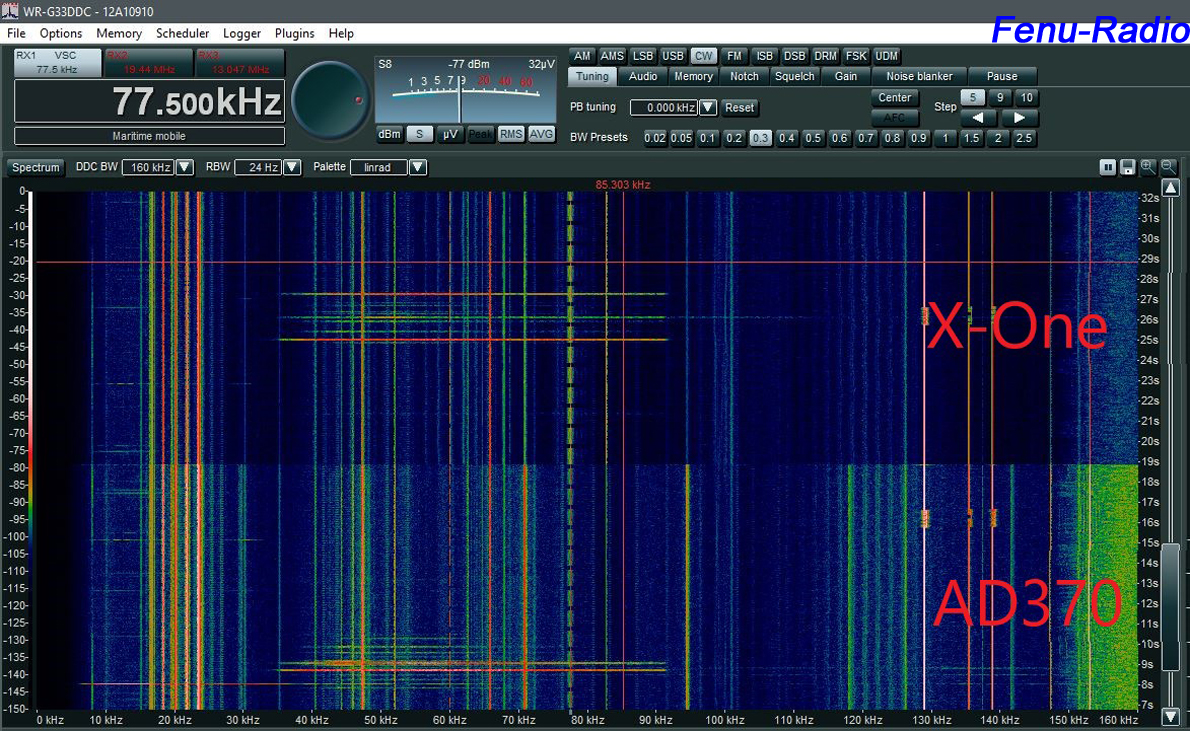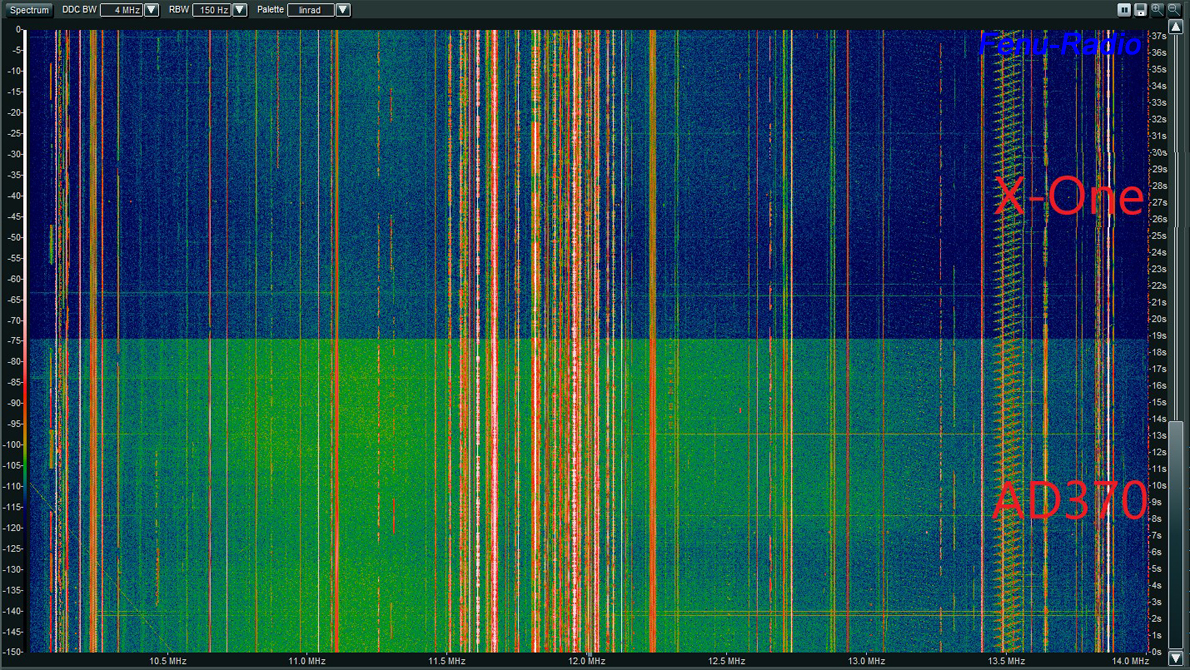|



Activdipole
Stampfl X-One
In
2019, I tested the first active dipole from Heinz Stampfl (HB9KOC).
This antenna was, so to speak, the revival of the forgotten active
dipole. Why this interesting antenna type was forgotten is a mystery
to me. There was only talk of the "magnetic loops" and their
excellent reception performance. And rightly so, of course! The
Stampfl active dipole found many enthusiastic fans after its market
launch. The reception was and is excellent for the small dimensions
of the antenna. Unfortunately, it was only sold as a kit, which
obviously made it difficult to distribute the antenna.
Now Heinz Stampfl is presenting the successor to his first active
dipole. The X-One! This antenna is now (almost) ready to be
assembled in the hands of the SWL.
.jpg)
The
most important technical data of the X-One
-- Frequency range: 90KHz - 150MHz (usable from 10KHz)
-- Polarization: Horizontal
-- Large signal strength IP3: 28dBm - IP2: 66dBm
-- High selection efficiency
-- Excellent common mode rejection
-- Power consumption 270mA / 12V
-- Mast mounting: 40-60mm
-- Total length of the antenna: 0.8m
-- Weight: approx. 900g
|
Scope of
delivery:
-- X-One
-- Bias Tee DCW-1
-- DC cable
-- Banana plug
-- N to BNC adapter
-- Claw clamp |
Unpacking, assembly
The X-One arrives largely assembled in a sturdy cardboard box. After
inspecting the contents of the package, it's time to assemble!
Only the dipole elements, the end caps and the claw clamp need to be
fitted. When fitting the dipole elements, make sure that the sealing
surfaces on the gray polycarbonate housing are not damaged.
Otherwise leaks may occur and moisture may penetrate the antenna
housing.
The two O-rings on the dipole elements are also very important for
tightness. These must lie neatly in the groove. A little tip at this
point: If available, lubricate the O-rings with a little silicone
grease. This keeps the rubber O-rings soft for a very long time.
Then tighten the screws inside the housing. Be careful not to slip
with the tool and damage the amplifier electronics. Unfortunately, a
tool stop was forgotten during the manufacture of the dipole
elements. This could have been two small milled recesses in the
round bar so that a wrench, for example, could be used to tighten
the dipole elements. Not everyone has a vice!
If you want to activate the FM lock, the jumpers J1 & J2 on the
amplifier board must be removed. Make sure that the neoprene seal on
the cover lies neatly in the groove. Then tighten the four corner
screws. Done!
.jpg)
Installation site and mast assembly
Ideally, the installation site for the X-One should have been
determined in advance. This should be a quiet HF location, as far
away as possible from domestic interference. The X-One is mounted on
an aluminum, steel or GRP mast. The mast diameter can range from
40mm to 60mm. It is also important that the antenna is as
free-standing as possible. Minimum distance to walls and trees
approx. 4m. The installation height is essential and should be at
least 5m. If the X-One is mounted higher than 10m, you should watch
out for overload effects. If this occurs, the installation height
should be reduced. The directivity of the X-One can be used to
suppress interference. As with loop antennas, active dipoles are
also directional antennas, primarily in the lower frequency ranges.
The higher the frequency, the more the directivity decreases. The
use of a rotor can be considered and increases the flexibility of
the antenna.
If the mast is metallic, it should be properly earthed. The X-One
itself does not need an earth connection because it already has its
counterweight through the second dipole element. An active dipole is
a symmetrical antenna.
Above: X-One
Below: Datong AD370 in a do-it-yourself housing.
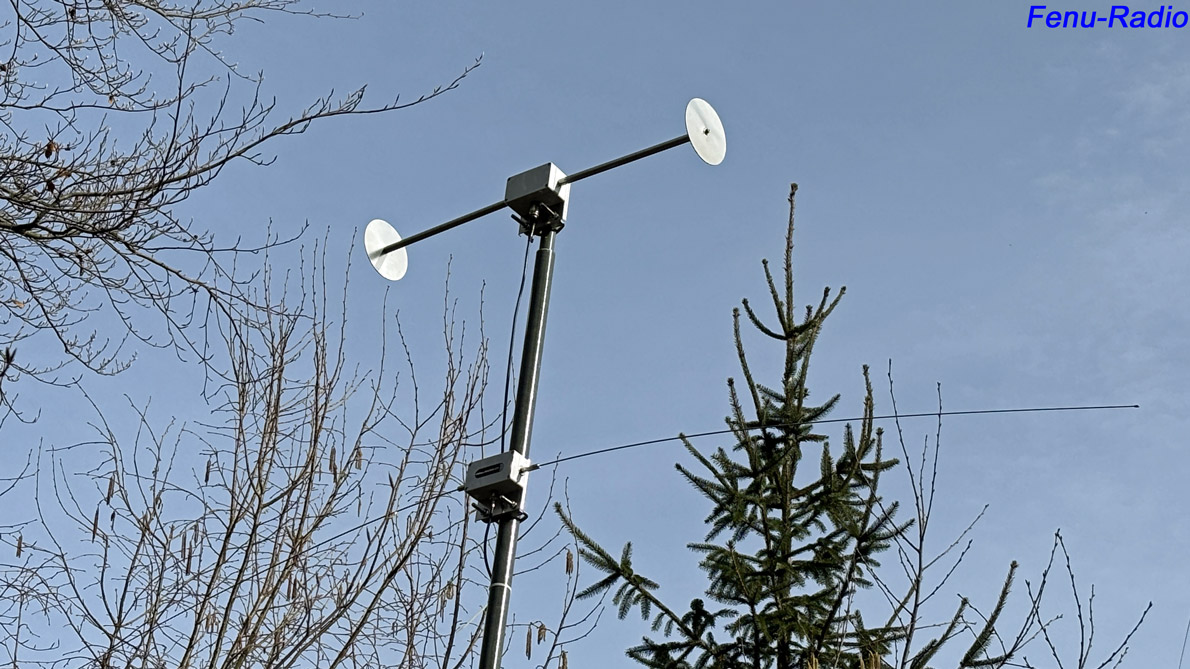
The receiving
direction of the active dipole. 90° offset to the dipole elements.

The appearance of
the X-One
Admittedly, an active dipole with these disks at the ends of the
dipole elements is unusual to look at, but nothing new in practice.
If you look at professional
active dipoles from Rohde & Schwarz,
you will notice that certain models have such disks fitted.
Why these disks? These are so-called capacitors and are used to
increase the capacitance and reduce the antenna size. If the
capacitance increases, the voltage at the dipole elements also
increases. This has a direct influence on the reception level.
.jpg)
Chasing waves with
the X-One
Test conditions
-- GRP masts
-- X-One superstructure height 5.5m
-- Installation height AD370 4.9m
-- Bias Tee the same for both antennas. Stampfl DCW-1
-- Coaxial cable Belden H155 for both antennas
-- Receiver Winradio Excalibur G33DDC
-- Elad ASA-62 antenna switch
I had the X-One in continuous operation for several months and was
able to get a good picture of the antenna.
The first thing that stands out is the antenna itself! With the
capacitors on the dipole elements, it looks very special. You could
be forgiven for thinking that a Rohde & Schwarz antenna is mounted
on the mast. Due to the thick dipole elements, the X-One is heavy
compared to the competition, the Datong AD370. I compared the X-One
with this tried and tested antenna, which is my reference antenna.
The AD370 is significantly lighter and not as conspicuous as the
X-One. However, the dipole elements are each 1.2m long and 2.5mm
thin.
Such thin dipole elements have their disadvantages, especially in
winter when there is snow. Then the thin dipole elements are
literally pressed down by the weight of the snow. This does not
affect the X-One with its thick dipole elements. It is made for this.
The mechanics are super-stable and defy all weather conditions.
Except for the round capacities at the ends of the dipole elements,
which provide a surface for the wind to attack.
Very good active dipoles are now available. It is becoming
increasingly difficult for testers to assess the reception
performance of these antennas. The reception performance is often
very close! Recording audio comparisons was almost not worthwhile in
this comparison. The differences are only audible at very weak
stations, if at all. Both antennas receive largely equally well.
Differences are only recognizable at the turf. And only if you
concentrate on the signal.
In the evening hours, when the sum signals increase and the levels
at some stations rise above S9+30dBm, slight clipping was noticeable
on the X-One. Intermodulation on twice the frequency was
particularly noticeable with signals from the 31m band. The AD370
also exhibited this behavior. However, only at higher signal
strengths around S9+35dBm and higher.
What the X-One can do much better than the AD370 is suppress common
mode interference. This can be seen very well in the lower frequency
ranges. Reception is significantly less noisy. As the frequency
increases, the overall level of the X-One decreases slightly, which
is noticeable with very weak stations in direct comparison.
Activating the FM lock has a slightly negative effect. The noise
floor increases slightly. Depending on the frequency range, this can
be up to 3dB. According to the manufacturer, this is due to
asymmetries in the FM cut-off.
Always use headphones to listen to the audio recordings.
Second 0-10 > X-One
Second 10-20 > AD370
18.3khz
RDL Russian Navy
 |
66.66khz
BPC Time Signal
 |
153khz
Antena Satelor
 |
1170khz
R. Capodistria
 |
3485khz
Gander Volmet
 |
6290khz
Piratensender NL
 |
8957khz
Shannon Volmet
 |
10051khz
Gander Volmet
 |
13020khz
Sound of Hope
 |
14670khz
Time Signal CHU
 |
21630khz
BBC Acension
 |
25000khz
Time Signal Colorado
 |
25900khz
BBC Talata Volondry
 |
28257khz
Bake DK0TEN
 |
Waterfall diagrams
Level differences between the two antennas are best seen in the
waterfall diagram. The dark blue represents the background noise.
The lighter the blue, the higher the noise floor. Basically, it can
be said that the level differences between the two antennas are max.
5-8dB. The SNR (signal-to-noise ratio) can also be roughly derived
from this. The more colored the lines (transmitter) are and the
darker the blue, the better the SNR.
Waterfall diagram below:
For the first time I made such a 0-30MHz diagram with highest
resolution. The JPG file is over 70MB in size. If you click on it, a
new browser window opens with the section below. This is greatly
enlarged. The 0-30MHz are displayed with a resolution of 1.5KHz. So
you can see every detail in the waterfall. I recommend to open this
file only with a fast internet connection. Otherwise use the
spectrum sections below. The sections are each 4Mhz wide.

Waterfall chart
sections:
0 - 160KHz , 0 - 4MHz, 2-6MHz, 6-10MHz
Waterfall chart sections:
10-14MHz, 14-18MHz, 18-22MHz, 22-26MHz, 26-30MHz
Reception in the FM range and up to 150MHz
According to the technical data, the X-One receives up to 150MHz.
The Datong AD370 should also receive up to 100MHz. Unfortunately,
the topographical location of my home does not allow very good FM
reception. Aircraft radio is just about possible. Anything above
that is not suitable for comparisons. The X-One has therefore only
been tested in this frequency range.
I made the comparisons with the ELAD FDM-S3/DCM.
Below is an almost
20MHz wide waterfall diagram of the VHF band. It clearly shows that
the X-One receives much better than the AD370. It delivers the
stations at a higher level with practically the same noise floor. In
other words, better SNR.
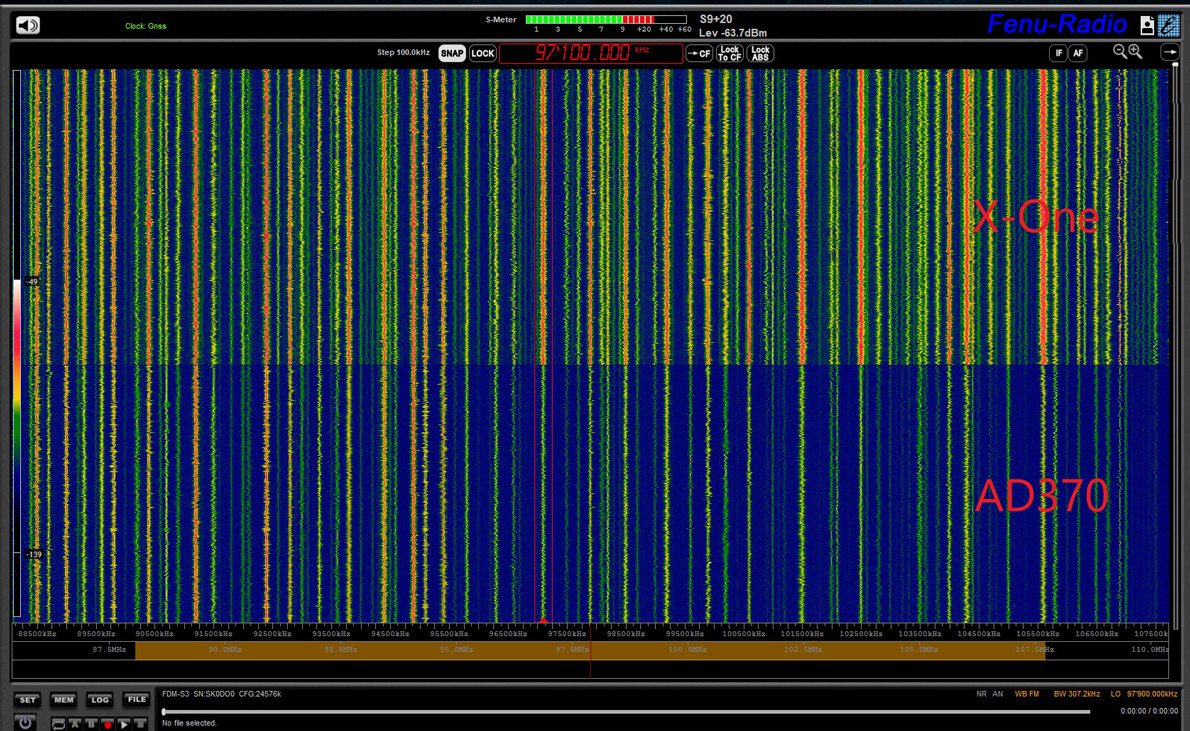
Use headphones to
listen to the audio recordings.
Second 0-10 > X-One
Second 10-20 > AD370
FM-89.0Mhz
300k-SWR4 FN
 |
FM-91.8Mhz
80k-SWR1
 |
FM-101.5Mhz
300k-SRF1
 |
FM-106Mhz
80k-Baden FM
 |
The entire
aeronautical radio band at a glance. Unfortunately, the radio
activity was very poor. The X-One receives quite well here too. The
AD370 drops off significantly, which is not surprising.
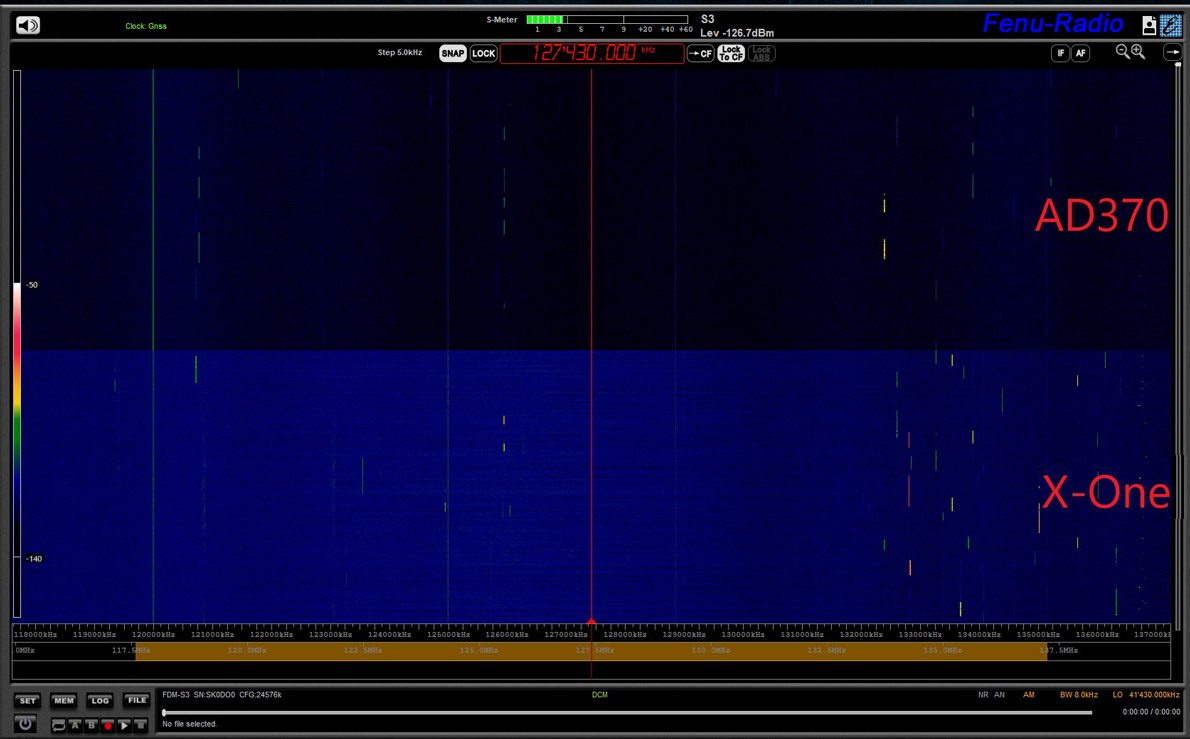
Conclusion:
The X-One stands out with its special look. It is robustly built
and can withstand many a storm.
It is supplied as a complete antenna and thus saves many SWLs the
annoying task of finding certain components such as housing, claw
clamp etc.. Installation is therefore completed quickly.
In terms of reception, the X-One is one of the top active antennas.
It impresses with very quiet and low-noise reception and is slightly
superior to the AD370 in some reception situations. The large signal
behavior on shortwave is not entirely convincing. With strong sum
signals, intermodulation can be heard here and there on twice the
transmitter frequency. If the FM lock is activated, the background
noise increases slightly, which is a disadvantage.
The X-One does not deliver a brutal level and is therefore also
suitable for cheaper receivers.
Reception in the FM broadcast band is good enough for normal
requirements.
An all-round successful antenna!
posted: 21.02.2024



|
.jpg)

.jpg)
.jpg)
.jpg)
.jpg)

.jpg)



.jpg)
.jpg)

.jpg)







